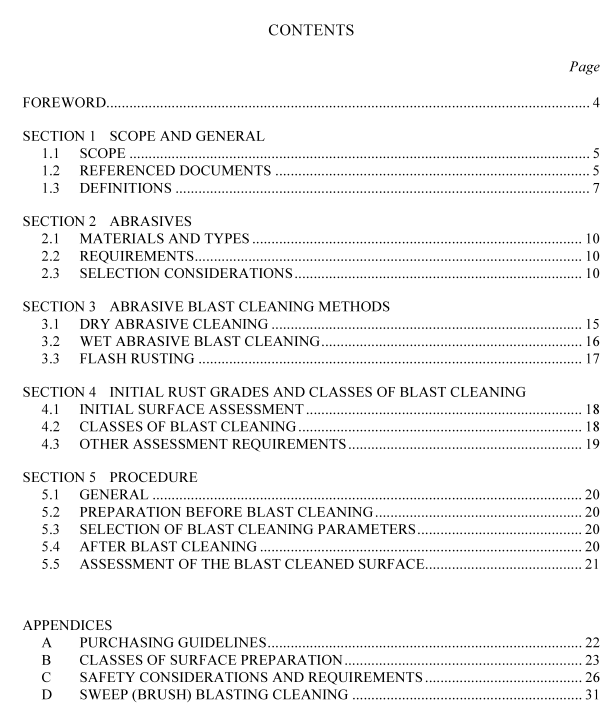AS 1627.4 pdf download – Metal finishing—Preparation and pretreatment of surfaces Part 4: Abrasive blast cleaning of steel

AS 1627.4 pdf download – Metal finishing—Preparation and pretreatment of surfaces Part 4: Abrasive blast cleaning of steel
1.3 DEFINITIONS
For the purposes of this Standard the following terms and definitions apply:1.3.1 Abrasive
Material which, when projected against a surface at high velocity, will wear and/or roughenthe surface.
1.3.2Abrasive blast cleaning
The cleaning and roughening of a surface by impingement of the abrasive onto a surface tobe prepared.
1.3.3Almandite garnet
Processed naturally occurring iron and aluminium silicate which is washed,dried andsieved,with or without mechanical crushing, and prepared for use as a blast cleaningabrasive.
1.3.4 Cast-steel shot
A steel abrasive material that is predominantly spherical in shape produced by a specialcasting process.
1.3.5 Chilled-iron grit
A metallic blast-cleaning abrasive obtained by crushing various chilled iron-shot sizes intosharp-edged angular particles.
1.3.6Chilled-iron shot
A cast iron abrasive that is predominantly spherical in shape produced by a special castingprocess.
1.3.7Corrosion inhibitor
A chemical added to the water used in wet abrasive cleaning or water blasting to reduce thesusceptibility of the surface to flash corrosion.
1.3.8 Cut steel wire
Sharp-edge steel particles used for abrasive blasting, having a length-to-diameter ratio oftypically 1:l cut so that faces are approximately at right angles to the centre-line.
1.3.9 Embedment
The residual of the abrasive remaining attached to the surface.1.3.10 Feathering (Feather edging)
Tapering the thickness of the edge of a dry paint film.1.3.11 Flash rust
Flash rust is the development of a thin iron oxide soon after blasting in the presence of highhumidity or moisture.
1.3.12 Foreign matter
Any material contamination of the abrasive.1.3.13 Fused aluminium oxide
A synthetic mineral blast cleaning abrasive, which is classified as two types,A and WA.
Type WA: This type consists of crystalline corundum which is whitish in colour andcontains at least 99% aluminium oxide.
1.3.14 Grit
Particles that are predominantly angular, that have fractured faces and sharp edges and thatare less than half-round in shape.
1.3.15 High-carbon cast-steel grit
A metallic blast cleaning abrasive obtained by crushing high-carbon cast-steel shot intosharp-edged angular particles.
1.3.16 lImenite
Natural occurring mineral sand which is separated, dried and sieved and prepared for use asa blast cleaning abrasive.
1.3.17 Preparation classes
Classification describing the quality of preparation achieved by a method of surfacecleaning.
1.3.18 Profile
See ‘Surface profile’ .
1.3.19 Profile comparatorSee ‘Surface profile comparator’.
1.3.20 Rust grades (Initial rust grades)
Classification describing the initial amount of mill scale and rust on a steel surface beforeany surface preparation has taken place.
1.3.21 Spot (Selective) blasting
The abrasive blast cleaning of a previously coated surface to produce areas of bare exposedmetal and areas of brush-blasted surface.
1.3.22 Shot
See ‘Cast steel shot’ .1.3.23Slag
A metal silicate abrasive manufactured by granulation in water, drying and sieving, with orwithout mechanical crushing processes, from slag originating from smelting operations. It isbasically iron silicate slag.
NOTE: Slags manufactured by air-cooling instead of granulation in water are generally of adifferent mineral structure and are therefore not covered by this Standard.
1.3.24 Staurolite
Natural occurring mineral sand which is separated, dried and sieved and prepared for use asa blast cleaning abrasives.
1.3.25Surface profile
The micro-roughness of a surface generally expressed as the height of the major peaksrelated to the major valleys.
NOTE: Methods of determining maximum profile height are given in AS 3894.5.
1.3.26 Surface profile comparator
A specimen surface, or surface of known average profile, representing a particular abrasive blast cleaning process.
1.3.27 Sweep (brush) blasting
Light abrasive blast cleaning to roughen the surface or remove light rust, foreign particlesand outer surface coating.
1.3.28 Visible rust and millscale
Rust or millscale which can be seen without magnification,with normal or corrected vision.1.3.29 water jetting
The method of cleaning a surface by the use of a jet of water under pressure.The jet ofwater may be accompanied by abrasives.
NOTE: This process is not specified by this Standard.1.3.30 wet abrasive blast cleaning
Abrasive blast cleaning of a surface by compressed air or mechanical means using amixture of abrasive and water, with or without air mixed into the abrasive stream.
1.3.31 Whipblast
An abrasive blast of a previous blast cleaned surface to restore a class of surfacepreparation which has deteriorated with time.









